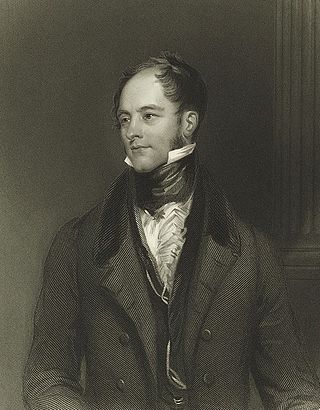
Henry Goulburn PC FRS was a British Conservative statesman and a member of the Peelite faction after 1846.

The Slavery Abolition Act 1833 was an Act of the Parliament of the United Kingdom which provided for the gradual abolition of slavery in most parts of the British Empire. It was passed by Earl Grey's reforming administration and expanded the jurisdiction of the Slave Trade Act 1807 and made the purchase or ownership of slaves illegal within the British Empire, with the exception of "the Territories in the Possession of the East India Company", Ceylon, and Saint Helena. The Act was repealed in 1998 as a part of wider rationalisation of English statute law; however, later anti-slavery legislation remains in force.

Slavery in the British and French Caribbean refers to slavery in the parts of the Caribbean dominated by France or the British Empire.

Compensated emancipation was a method of ending slavery, under which the enslaved person's owner received compensation from the government in exchange for manumitting the slave. This could be monetary, and it could allow the owner to retain the slave for a period of labor as an indentured servant. Cash compensation rarely was equal to the slave's market value.

Slavery in Britain existed before the Roman occupation and until the 11th century, when the Norman conquest of England resulted in the gradual merger of the pre-conquest institution of slavery into serfdom, and all slaves were no longer recognised separately in English law or custom. By the middle of the 12th century, the institution of slavery as it had existed prior to the Norman conquest had fully disappeared, but other forms of unfree servitude continued for some centuries.

Antoine Zacharie Adrien d'Épinay was a Franco-Mauritian lawyer, politician and slave-owner.
Benjamin Greene was an English businessman, newspaper owner and the founder of Greene King, one of the United Kingdom's largest brewing businesses. He later became the owner of multiple plantations in the British West Indies and supported slavery.

Reparations for slavery is the application of the concept of reparations to victims of slavery and/or their descendants. There are concepts for reparations in legal philosophy and reparations in transitional justice. Reparations can take many forms, including practical assistance to the descendants of enslaved people, acknowledgements or apologies to peoples or nations negatively affected by slavery, or honouring the memories of people who were enslaved by naming things after them.
Benjamin Buck Greene was a British banker, plater, and financier. He inherited a large fortune derived from the Atlantic slave trade and the sugar industry in the Caribbean, later becoming one of London's leading merchants and shipowners. He served as a director of the Bank of England for fifty years from 1850, also serving as deputy governor (1871-3) and governor (1873–5).

Abolitionism in the United Kingdom was the movement in the late 18th and early 19th centuries to end the practice of slavery, whether formal or informal, in the United Kingdom, the British Empire and the world, including ending the Atlantic slave trade. It was part of a wider abolitionism movement in Western Europe and the Americas.
Abraham Wildey Robarts (1779–1858), of Hill Street, Berkeley Square, Middlesex, was an English politician and banker.
James Blair was a Ulster-Scots owner of plantations in the West Indies. He entered Parliament as a Tory in 1818 to protect the interests of slave-owners. Blair sat in the House of Commons from 1818 to 1830, and later from 1837 to 1841.

Hope Botanical Gardens, also known as the Royal Botanical Gardens, is a 200-acre (81 ha) park and gardens located in St Andrew, Jamaica.

The Centre for the Study of the Legacies of British Slavery, formerly the Centre for the Study of the Legacies of British Slave-ownership, is a research centre of University College, London (UCL) that focuses on revealing the impact of British slavery and, in particular, the implications of the Slave Compensation Act 1837. The Centre's work is freely available online to the public through the Legacies of British Slavery database.
Charles McGarel (1788–1876) was an Ireland-born Ulster-Scots merchant and slave owner. In 1833, the British Government abolished slavery and compensated owners, such as McGarel, who became a major beneficiaries of this scheme. With his wealth he conducted business in the City of London, funded civic works in his home town of Larne, County Antrim and bought land and property in Ireland. Having no children, he left his estate to his brother-in-law, James Hogg, on condition that he integrate McGarel into his family name, becoming James McGarel-Hogg, later Lord Magheramorne.
Hamilton Brown was a Scots-Irish planter, slave owner, and politician in Saint Ann Parish, Jamaica, which he represented in the House of Assembly of Jamaica for 22 years. Brown founded the settlement of Hamilton Town in Saint Ann Parish, which was named after him.
George William Hamilton was a planter in Jamaica. He was elected to the House of Assembly of Jamaica in 1820.
William Dickinson (1771–1837) was an English politician, in parliament from 1796 to 1831.
Alexander Bravo, sometimes spelled Alexandre Bravo, was a Jamaican-born Sephardic Jewish merchant, politician, slave plantation owner and Auditor-General of Jamaica. Bravo was the first Jew to be elected to the House of Assembly of Jamaica.
Judah Mordechai Cohen was a Dutch-born London-based Jewish merchant and slave plantation owner with interests in Jamaica. With over 1255 slaves on his plantations, Cohen was one of the most extensive slave owners in Jamaica and the British West Indies in general at the time of the Slavery Abolition Act 1833. He had been involved in trade in the West Indies as a partner of his older brother Hymen Cohen since 1804.







